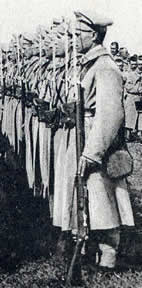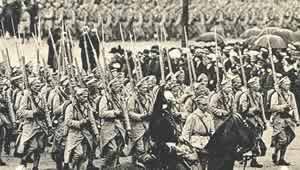
Battles Haller Troops Fought In
WWI - FRANCE
 On June 18, 1918, the first of the newly formed Polish forces finally got their chance to join in the fighting in France. The First Polish Regiment relieved the Tennessee "Wildcat" 81st Division at the front in the Champagne region. This First Polish Regiment was made up of a variety of men including former POW's from Europe, but the large majority (around 3 quarters) of the men where Polish volunteers from America.
On June 18, 1918, the first of the newly formed Polish forces finally got their chance to join in the fighting in France. The First Polish Regiment relieved the Tennessee "Wildcat" 81st Division at the front in the Champagne region. This First Polish Regiment was made up of a variety of men including former POW's from Europe, but the large majority (around 3 quarters) of the men where Polish volunteers from America.
Their fighting during this first combat won them recognition of their valor at a special military review held four days later. This event marked the first time since 1831 that an army unit flying the Polish colors had taken part in battle, a truly historic moment for Poles and their hopes of independence!
The first Polish American officer to give his life in fighting in France was Second Lieutenant Lucjan Chwalkowski. He had been a member of the Falcons from New York.
As part of the Fourth French Army, the First Polish Regiment continued to participate in heavy fighting along the Western Front through the summer and fall of 1918. In July they played an active role in beating back the German offensive on the Marne River. This was the second battle of the Marne.
Additionally they helped capture the town of Auberive and repel the German 66th Regiment at Bois Raquette (near Saint Hilary le Grand). Further action continued in battles near Rheims, Mere Henry, Alsace and Lotharingia, the latter of which they won much French praise.
The French military command ordered the Polish forces to be combined into one Polish Army division on August 3, 1918. This first completely Polish division was comprised of 9,965 troops and 227 officers. They were organized into three infantry regiments, one company of engineers, one squad of light calvary and an artillery brigade. It was not until October 6, 1918, that General Jozef Haller officially took command of the Polish forces fighting in France.
 To honor their contribution to the fighting the Polish forces were included in the victory parade in Paris. Now officially under General Haller's command, they marched as a full Allied unit.
To honor their contribution to the fighting the Polish forces were included in the victory parade in Paris. Now officially under General Haller's command, they marched as a full Allied unit.
Their total losses during the 1918 campaign were 206 killed in action, 106 of who were volunteers from America. A total of 862 were wounded plus an additional 15 others suffered permanent disability.
After the war was over there was much debate as to what would become of this Polish Army. Pilsudski had emerged from captivity and was now the leader in Poland. The Haller Army had been closely associated with Roman Dmowski, a political adversary of Pilsudski's, who was trying to become head of the Polish government. Due to strains between Dmowski and Pilsudski, the Allies feared a civil war in Poland if the Haller Army was transported there before stablity was established.
Eventually Ignacy Paderewski worked out a deal with Pilsudski that managed to merge the two opposing camps, but allowed Pilsudski official control. Once that hurdle was past, there was a bigger problem ahead, trouble with the Bolsheviks now in power in Russia. The German Army had withdrawn from the area between Poland and Russia and the void created was filled by both Polish and Russian forces each looking to establish the new boundry in their favor.
The Bolsheviks planned to spread their revolution west through Germany and the rest of Europe. The fledgling independent Poland stood in their way. Poland desperately needed her army to be able to protect her from the growing threat. The Haller Army was well equipped, well trained and well supplied. It was the only Polish force up to WWI standards in regards to training and equipment, and they were needed in Poland.
Germany refused to allow an armed foreign army to be transported across her or through the port of Danzig. They feared losing Danzig to this Polish Army. After many talks they finally agreed and the Haller Army was transported across Germany in sealed train cars. As part of the agreement they had to be unarmed with their weapons locked in seperate cars. Finally in the spring of 1919 the Haller Army began transport on trains and was soon arriving in Poland.
The Haller Army only existed officially for about seven months from October 1918 to around May 1919 when it was dispersed into the existing Polish Army. Origninally General Haller was told his forces would remain together for 1 year, but this was not to be.
The bulk of the volunteers from America made up the the first three regiments of the 1st Polish Infantry Division in France. Upon arrival in Poland they were reorganized into the 43rd Kresowy Infantry Rifle Regiment, the 44th Kresowy Infantry Rifle Regiment and the 45th Kresowy Infantry Rifle Regiment of the 13th Infantry Division of the Second Army Corps. The 8th regiment was also moved into the 50th Kresowy Regiment.
1919 UKRAINE
The 43rd, 44th and 45th regiments were immediately moved to the Ukraine where fighting had began with Ukrainian forces. They served in the sector Zimno-Poryck-Grochow-Beresteczko where they were involved in seizing and holding railway line junctions. The 44th attacked Kowel-Luck and the 45th captured the juncture at Czarkow-Radomysl. Later in May the 44th suffered heavy losses during the defense of Luck but managed to capture about 70 square miles of territory. After that the 43rd and 44th held defensive duties in a large sector nearby.
The 45th Regiment was later transferred to Upper Silesia for defensive purposes during the plebiscite. They remained there until July 1919.
Polish - Soviet War 1919-1920
Polish-American troops first encountered Soviet troops on June 8, 1919 near Rowne. The 13th Division fought through the summer of 1919 capturing a number of towns including Sarny and Zaslaw. Their advance stopped in the area around Pinsk at the rivers Styr, Pripet and Zbrucz and they held there for a cease fire agreement with Seymon Petlura.
Random incursions and fighting continued as both sides harassed the other in small skirmishes. Polish troops would try to entrap small groups of Soviet troops as well as raid garrisons for food, ammunition and to spread panic amongst the enemy. Through this process the 13th Division moved the front line eastward a considerable distance.
to be continued...
It is in their memory and the memory of their deeds that
this site is dedicated.
We need your help (information and
artifacts) to build this site!
| Help build this site! Please contribute in any way you can - stories, photos, memorabilia or feedback appreciated! I also collect items on this subject and will consider making purchases of items. |
Sponsored Items:
|
Kosciuszko Squadron Model Plane
|